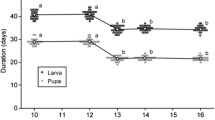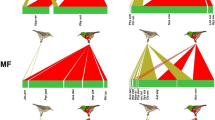Abstract
The monarch butterfly, Danaus plexippus L. (Lepidoptera: Nymphalidae), is found across North America during the summer months. Adult populations from western North America migrate to roost along the central coast of California. Monarchs that disperse in the spring to the arid regions of southern California encounter widely dispersed individuals of desert milkweed species, including Asclepias fascicularis Decne. (Narrow-Leaf Milkweed), A. californica E. Greene (California Milkweed), A. eriocarpa Benth. (Indian Milkweed), and A. erosa Torrey (Desert Milkweed). The four species represent a range in suitability as hosts for monarch larvae. In laboratory assays of plants grown from wild-collected seeds, neonate larvae showed the least preference for A. fascicularis in host-selection assays and there were no differences in preference among the other three species. Previous research has shown that A. fascicularis has the lowest level of cardiac glycosides and the lowest latex flow of the four species examined. The leaf hairs of A. californica and A. eriocarpa provide a significant barrier to neonate larval success; larvae feeding on shaved leaves were significantly larger than larvae feeding on leaves with intact hairs. First instar larval behavior of cutting hairs before beginning to feed may improve their success by modifying plant quality and defenses.
Similar content being viewed by others
References
Abbas A, Luttrell RG, Pitre HN (1990) Feeding sites and distribution of fall armyworm (Lepidoptera: Noctuidae) larvae on cotton. Environ Entomol 19:1060–1067
Agrawal AA, Konno K (2009) Latex: a model for understanding mechanisms, ecology, and evolution of plant defense against herbivory. Annu Rev Ecol Syst 40:311–331
Agrawal AA, Fishbein M (2006) Plant defense syndromes. Ecology 87:S132–S149
Agrawal AA, Hastings AP, Patrick ET, Knight AC (2014) Specificity of herbivore-induced hormonal signaling and defensive traits in five closely related milkweeds (Asclepias spp.). J Chem Ecol 40:717–729
Bernays EA, Chapman RF, Woodhead S (1983) Behavior of newly hatched larvae of Chilo partellus (Swinhoe) (Lepidoptera: Pyralidae) associated with their establishment in the host-plant, sorghum. Bull Entomol Res 73:75–83
Biondini ME, Mielke PW Jr, Redente EF (1988) Permutation techniques based on Euclidean analysis spaces: a new and powerful statistical method for ecological research. Coenoses 3:155–174
Brower LP (1961) Studies on the migration of the monarch butterfly. 1. Breeding populations of Danaus plexippus and D. berenice in south central Floirda. Ecology 43:549–552
Brower LP (1977) Monarch migration. Nat Hist 86:41–53
Brower LP (1995) Understanding and misunderstanding the migration of the monarch butterfly (Nymphalidae) in North America: 1857–1995. J Lepidopterol Soc 49:304–385
Brower LP, Seiber JN, Nelson CJ, Lynch SP, Hoggard MP, Cohen LA (1984) Plant-determined variation in cardenolide content and thinlayer chromatography profiles of monarch butterflies, Danaus plexippus reared on milkweed plants in California. 3. Asclepias californica. J Chem Ecol 10:1823–1857
Cockfield SD, Mahr DL (1993) Consequences of feeding site selection on growth and survival of young blackheaded fireworm (Lepidoptera: Tortricidae). Environ Entomol 22:607–612
Cohen J, Brower LP (1982) Oviposition and larval success of wild monarch butterflies (Lepidopdera: Danaidae) in relation to host plant size and cardenolide concentration. J Kans Entomol Soc 55:343–348
De Roode JC, Lopez Fernandez de Castillejo C, Faits T, Alizon S (2011) Virulence evolution in response to anti-infection resistance: toxic food plants can select for virulent parasites of monarch butterflies. J Evol Biol 24:712–722
De Roode JC, Pederson AB, Hunter MD, Altizer S (2008) Host plant species affect virulence in monarch butterfly parasites. J Anim Ecol 77:120–126
Dingle H, Zalucki MP, Rochester WA, Armijo-Prewitt T (2005) Distribution of the monarch butterfly, Danaus plexippus L. (Lepidoptera: Nymphalidae), in western North America. Biol J Linn Soc 85:491–500
DiTommaso A, Losey J (2003) Oviposition preference and larval performance of monarch butterflies (Danaus plexippus) on two invasive swallow-wort species. Entomol Exp Appl 108:205–209
Dixon CA, Erikson JM, Kellet DN, Rothschild M (1978) Some adaptations between Danaus plexippus and its food plant with notes on Danaus chrysippus and Euploea core (Insecta: Lepidoptera). J Zool 185:437–467
Dussourd DE, Denno RF (1991) Deactivation of plant defense: correspondence between insect behavior and secretory canal architecture. Ecology 72:1383–1396
Dussourd DE, Eisner T (1987) Vein-cutting behavior: insect counterploy to the latex defense of plants. Science 237:898–901
Farrer RRJ, Bradley JRJ (1985) Effects of within-plant distribution of Heliothis zea (Boddie) (Lepidoptera: Noctuidae) eggs and lavae on larval development and survival on cotton. J Econ Entomol 78:1233–1237
Foster SP, Howard AJ (1999) Adult female and neonate larval plant preferences of the generalist herbivore, Epiphyas postvittana. Entomol Exp Appl 92:53–62
Gowler CD, Leon KE, Hunter MD, de Roode JC (2015) Secondary defense chemicals in milkweed reduce parasite infection in monarch butterflies, Danaus plexippus. J Chem Ecol 41:520–523
Haribal M, Renwick JAA (1998a) Differential postalightment oviposition behavior of monarch butterflies on Asclepias species. J Inst Behav 11:507–538
Haribal M, Renwick JAA (1998b) Identification and distribution of oviposition stimulants for monarch butterflies in hosts and nonhosts. J Chem Ecol 24:891–904
Hochberg ME (1987) The within-plant distribution and feeding behavior of Heliothis armigera (Lep., Noctuidae) on greenhouse tomatoes. J Appl Entomol 104:256–261
Hulley PE (1988) Caterpillar attacks plant mechanical defence by mowing trichomes before feeding. Ecol Entomol 13:239–241
Jackson DM (1982) Searching behavior and survival of 1st-instar codling moths. Ann Entomol Soc Am 75:284–289
Knight A, Brower LP (2009) The Influence of Eastern North American autumnal migrant monarch butterflies (Danaus plexippus L.) on continuously breeding resident monarch populations in southern Florida. J Chem Ecol 35:816–823
Ladner DT, Altizer S (2005) Oviposition preference and larval performance of North American monarch butterflies on four Asclepias species. Entomol Exp Appl 116:9–20
Leddy PM, Paine TD, Bellows TS Jr (1993) Ovipositional preference of Siphoninus phillyreae and its fitness on seven host plant species. Entomol Exp Appl 68:43–50
Leddy PM, Paine TD, Bellows TS Jr (1995) Biology of Siphoninus phillyreae (Haliday) (Homoptera: Aleyrodidae) and its relationship to temperature. Environ Entomol 24:380–386
Lefevre T, Chiang A, Kelavkar M, Li H, Li J, Lopez Fernandez de Castillejo C, Oliver L, Potini Y, Hunter MD, De Roode JC (2012) Behavioral resistance against a protozoan parasite in the monarch butterfly. J Anim Ecol 81:70–79
Lucansky TW, Clough KT (1986) Comparitive anatomy and morphology of Asclepias perennis and Asclepias tuberosa subspecies rolfsii. Bot Gaz 147:290–301
Malcolm SB (1991) Cardenolide-mediated interactions between plants and herbivores. In: Rosenthal GA, Berenbaum MR (eds) Herbivores: their interactions with secondary plant metabolites, 2nd edn. Academic, San Diego, pp 251–291
Malcolm SB (1995) Milkweeds, monarch butterflies and the ecological significance of cardenolides. Chemoecol 5/6:101–117
Malcolm SB, Brower LP (1986) Selective oviposition by monarch butterflies (Danaus plexippus L.) in a mixed stand of Asclepias curassavica L. and A. incarnate L. in South Florida. J Lepidopterol Soc 40:255–263
Malcolm SB, Brower LP (1989) Evolutionary and ecological implications of cardenolide sequesteration in the monarch butterfly. Experientia 45:284–295
Matkin OA, Chandler PA (1957) The U.C. soil type mixes. In Baker KF (ed.) The U.C. system for producing healthy container-grown plants. University of California Agricultural Experiment Station Manual 23:68–85. University of California, Berkeley, CA
Mayhew PJ (1997) Adaptive patterns of host-plant selection by phytophagous insects. Oikos 79:417–428
Munz PA, Keck DD (1968) A California Flora. University of California Press, Berkeley
Oberhauser KS, Solensky MJ (2002) The monarch butterfly: Biology and conservation. Preface. Cornell University Press, Ithaca
Oyeyele SO, Zalucki MP (1990) Cardiac glycosides and oviposition by Danaus plexippus on Asclepias fruticosa in south-east Queensland (Australia), with notes on the effect of plantnitrogen content. Ecol Entomol 15:177–185
Pierce AA, Zalucki MP, Bangura M, Udawatta M, Kronforst MR, Altizer S, Fernández Haeger J, de Roode JC (2014) Serial founder effects and genetic differentiation during worldwide range expansion of monarch butterflies. Proc Royal Soc B Biol Sci 281:20142230–20142230
Rausher MD (1984) Trade-offs in performance on different hosts: evidence for within- and between-site variation in the beetle Deloyala guttata. Evol 38:582–595
Shephard JM, Hughes JM, Zalucki MP (2002) Genetic differentiation between Australian and North American populations of the monarch butterfly Danaus plexippus (L.) (Lepidoptera: Nymphalidae): an exploration using allozyme electrophoresis. Biol J Linn Soc 75:437–452
Sternberg ED, Lefevre T, Li J, Lopez Fernandez de Castillejo C, Li H, Hunter MD, de Roode JC (2012) Food plant-derived disease tolerance and resistance in a natural butterfly-plant-parasite interactions. Evolution 66:3367–3376
Thompson NT (1988) Evolutionary ecology of the relationship between oviposition preference and performance of offspring in phytophagous insects. Entomol Exp Appl 47:3–14
Urquhart FA (1987) The Monarch Butterfly: International Traveler. University of Toronto Press, Toronto
Vane-Wright R (1993) The Columbus Hypothesis: an explanation for the dramatic range expansion of the monarch butterfly. pp. 179–186. In Solensky MJ, Oberhauser KS (eds.) Biology and Conservation of the Monarch Butterfly Natural History Museum of Los Angeles County, Los Angeles, CA
Zalucki MP (1982) Temperature and rate of development in two species of Danaus, D. plexippus and D. chrysippus. J Austr Entomol Soc 21:241–46
Zalucki MP (1986) The monarch butterfly - a non-pest exotic insect. In: Kitching RL (ed) The ecology of exotic animals and plants: Some Australian case studies. Wiley, New York, pp 130–142
Zalucki MP, Brower LP (1992) Survival of first instar larvae of Danaus plexippus (Lepidoptera: Danainae) in relation to cardiac glycoside and latex content of Asclepias humistrata (Asclepiadaceae). Chemoecology 3:81–93
Zalucki MP, Clarke AR (2004) Monarchs across the Pacific: the Columbus hypothesis revisited. Biol J Linn Soc 82:111–121
Zalucki MP, Kitching RL (1982) Dynamics of oviposition in Danaus plexippus (Insecta: Lepidoptera) on milkweed, Asclepias spp. J Zool 198:103–116
Zalucki MP, Malcolm SB (1999) Plant Latex and First-Instar Monarch Larval Growth and Survival on Three North American Milkweed Species. J Chem Ecol 25:1827–1842
Zalucki MP, Oyeyele S, Vowles P (1989) Selective oviposition by Danaus plexippus L. (Lepidoptera: Nymphalidae) in a mixed stand of Asclepias fruticosa and A. curassavica in southeast Queensland. J Aust Entomol Soc 28:141–146
Zalucki MP, Brower LP, Malcolm SB (1990) Oviposition by Danaus plexippus in relation to cardenolide content of three Asclepias species in southeastern USA. Ecol Entomol 15:231–240
Zalucki MP, Brower LP, Alonso A (2001a) Detrimental effects of latex and cardiac glycosides on survival and growth of first-instar monarch butterfly larvae Danaus plexippus feeding on the sandhill milkweed Asclepias humistrata. Ecol Entomol 26:212–224
Zalucki MP, Malcolm SB, Paine TD, Hanlon CC, Brower LP, Clarke AR (2001b) It’s the first bite that counts: survival of first-instar monarchs on milkweeds. Austral Ecol 26:547–555
Zalucki MP, Clarke AR, Malcolm SB (2002) Ecology and behavior of first instar larval Lepidoptera. Annu Rev Entomol 47:361–393
Zalucki MP, Malcolm SB, Hanlon CC, Paine TD (2012) First-instar monarch larval growth and survival on milkweeds in southern California: effects of latex, leaf hairs and cardenolides. Chemoecology 22:75–88
Acknowledgments
We thank Christopher Hanlon for culturing the milkweed species and providing assistance in rearing the butterflies. We also thank M.E. Jones and R. Waterworth for careful review of the manuscript. The research was conducted to fulfill the requirements of a M.S. degree in Evolution, Ecology and Organismal Biology for GFR.
Conflict of Interest
The authors declare that they have no conflict of interest.
Author information
Authors and Affiliations
Corresponding author
Rights and permissions
About this article
Cite this article
Robertson, G.F., Zalucki, M.P. & Paine, T.D. Larval Host Choice of the Monarch Butterfly (Danaus plexippus L.) on Four Native California Desert Milkweed Species. J Insect Behav 28, 582–592 (2015). https://doi.org/10.1007/s10905-015-9524-2
Revised:
Accepted:
Published:
Issue Date:
DOI: https://doi.org/10.1007/s10905-015-9524-2




